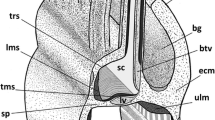Abstract
The hypophysis of early larval stages, from the moment of hatching on the 18th day after fertilization to the 101st day of larval life, of the arctic lamprey Lampetra japonica was studied with scanning and transmission electron microscopes. A solid cord of cells of the distal part of the nasopharyngeal duct represents the early adenohypophysis. On the 20th day after fertilization, several of the epithelial cells of this structure showed first indications of secretory activity with an extensive Golgi apparatus and small electron-dense secretory granules. On the 26th day, non-secretory, stellate (=supporting) cells and secretary cells can be distinguished. Already on the 39th day, two different parts can be distinguished in the adenohypophysis: the pars distalis with cells containing small dense granules, and the pars intermedia with cells containing larger granules of medium density. The number of granulated cells increases steadily; on the 101st day two pars distalis cell types can be distinguished. The neurohypophysis consists of a thin anterior and a thick posterior part. Already on the 20th day single nerve terminals in the ependymal layer of the diencephalic (=infundibular) floor contain dense elementary granules. The number of granule-containing terminals increases steadily; on the 101st day almost all terminals contain granules. The present observations suggest an early secretory function of the lamprey hypophysis.
Similar content being viewed by others
References cited
Bage, G. 1967. Ultrastructure of the adenohypophysis of adult migrating Lampetra fluviatilis. Gen. Comp. Endocrinol. 9: 429–430.
Bage, G. and Fernholm, Bo. 1975. Ultrastructure of the proadenohypophysis of the river lamprey, Lampetra fluviatilis, during gonad maturation. Acta Zool. 56: 95–118.
Ball, J.N. and Baker, B.I. 1969. The pituitary gland: anatomy and histophysiology. In Fish Physiology, Vol. 2 pp. 1–110. Edited by W. S. Hoar and D. J. Randall. Academic Press, New York.
Chiba, A. and Honma, Y. 1989. Somatostatin- and luteinizing hormone-releasing hormone-like immunoactivities in the brains of the arctic lamprey and the gummy shark. In Abstracts of XIth Internat. Symposium on Comparative Endocrinology, Malaga.
Fontaine, Y.-A. 1985. Hormonal peptide evolution. In Evolutionary Biology of Primitive Fishes. pp. 413–432. Edited by R.E. Foreman, A. Gorbman, J.M. Dodd and R. Olsson. Plenum Press, New York.
Gorbman, A. 1980. Endocrine regulation in Agnatha: Primitive or degenerate? In Hormones, Adaptation and Evolution. pp. 81–92. Edited by S. Ishii, T. Hirano and M. Wada. Japan Sci. Soc. Press, Tokyo/Springer-Verlag, Berlin.
Gorbman, A. 1965. Vascular relations between the neurohypophysis and adenohypophysis of cyclostomes and the problem of evolution of hypothalamic endocrine control. Arch. Anat. Microsc. Morphol. Exp. 54: 163–194.
Gorbman, A. and Tamarin, A. 1985a. Head development in relation to hypophysial development in a myxinoid, Eptatretus and a petromyzontid, Petromyzon. In The Pars Distalis: Structure, Function and Regulation. pp. 3–14. Edited by F. Yoshimura and A. Gorbman. Elsevier, Amsterdam.
Gorbman, A. and Tamarin, A. 1985b. Early development of oral, olfactory and adenohypophyseal structures of agnathans and its evolutionary implications. In Evolutionary Biology of Primitive Fishes. pp. 165–185. Edited by R.E. Foreman, A. Gorbman, J.M. Dodd and R. Olsson. Plenum Press, New York and London.
Honma, Y. 1960. The morphology of the pituitary gland of the sea-lamprey, Lampetra (=Entosphenus) japonica (Martens), during its anadromous period. Jap. J. Ichthyol. 8: 29–34 (in Japanese with English summary).
Honma, Y. 1969. Some evolutionary aspects of the morphology and role of the adenohypophysis in fishes. Gunma Symp. Endocrinol. 6: 19–37.
Kamer, J.C. van de and Schreurs, A.F. 1959. The pituitary gland of the brook lamprey (Lampetra planeri) before, during and after metamorphosis (a preliminary, qualitative investigation). Z. Zellforsch. 49: 605–630.
Kupffer, C. von. 1894. Studien zur vergleichenden Entwicklungsgeschichte des Kopfes der Kranioten. II. Die Entwicklung des Kopfes von Ammocoetes planeri. Verlag J. F. Lehmann, München.
Larsen, L.O. and Rothwell, B. 1972. Adenohypophysis. In The Biology of Lampreys. Vol. 2, pp. 1–62. Edited by M.W. Hardisty and I.C. Potter, Academic Press, New York.
Leach, W.J. 1951. The hypophysis of lampreys in relation to the nasal apparatus. J. Morphol. 89: 217–246.
Nozaki, M. 1985. Tissue distribution of hormonal peptides. In Evolutionary Biology of Primitive Fishes. pp. 433–454. Edited by R.E. Foreman, A. Gorbman, J.M. Dodd and R. Olsson. Plenum Press, New York.
Percy, R., Leatherland, J.F. and Beamish, F.W.H. 1975. Structure and ultrastructure of the pituitary gland in the sea lamprey, Petromyzon marinus, at different stages in its life cycle. Cell Tiss. Res. 157: 141–164.
Piavis, G.W. 1971. Embryology. In The Biology of Lampreys. pp. 361–400. Edited by M.W. Hardisty and I.C. Potter. Academic Press New York.
Sholdice, J.A. and McMillan, D.B. 1985. Pituitary cysts in the sea lamprey of the Great Lakes, Petromyzon marinus. Gen. Comp. Endocrinol. 57: 135–149.
Tahara, Y. 1988. Normal stages of development in the lamprey Lampetra reissneri (Dybowski). Zool. Sci. 5: 109–118.
Tilney, F. 1937. The hypophysis cerebri in Petromyzon marinus dorsatus Wilder. Bull. Neur. Inst. New York 6: 70–117.
Tsuboi, K. 1953. A cyto-histological study of the hypophysis of cyclostomes. Acta Inst. Anat. Niigataensis, 25: 97–145 (In Japanese).
Tsuneki, K. and Gorbman, A. 1975a. Ultrastructure of pars nervosa and pars intermedia of the lamprey, Lampetra tridentata. Cell Tiss. Res. 157: 165–184.
Tsuneki, K. and Gorbman, A. 1975b. Ultrastructure of the anterior neurohypophysis and the pars distalis of lamprey, Lampetra tridentata. Gen. Comp. Endocrinol. 25: 487–508.
Wingstrand, K.G. 1966. Comparative anatomy and evolution of the hypophysis. In The Pituitary Gland. Edited by G.W. Harris and B.T. Donovan. pp. 58–126. Butterworths, London.
Author information
Authors and Affiliations
Rights and permissions
About this article
Cite this article
Honma, Y., Chiba, A. & Welsch, U. Development of the hypophysis of the arctic lamprey, Lampetra japonica . Fish Physiol Biochem 8, 355–364 (1990). https://doi.org/10.1007/BF00003367
Issue Date:
DOI: https://doi.org/10.1007/BF00003367




